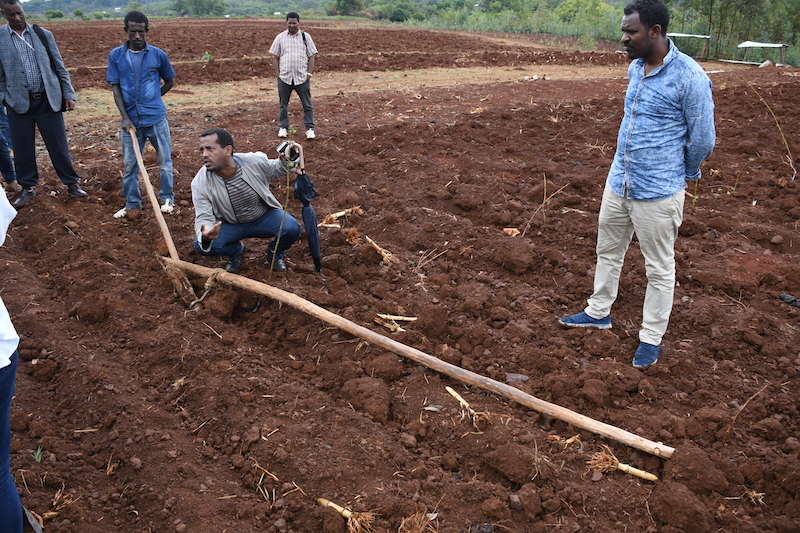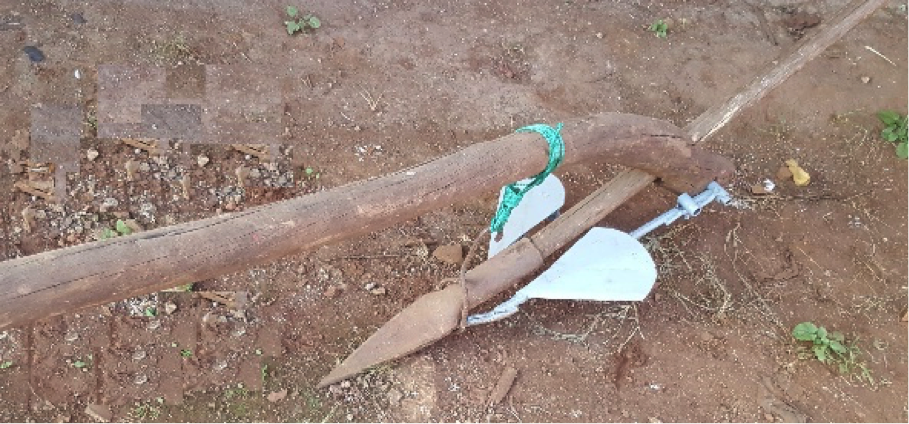Expanding the use of small scale irrigation requires problem solving across sectors. The Feed the Future Innovation Lab for Small Scale Irrigation (ILSSI) is partnering with private sector actors who can play important roles in developing and bringing to market innovative technologies. That’s what Melesse Temesgen, General Manager of Aybar Engineering PLC, did when he invented a new plow with numerous benefits, including increased infiltration of rainwater. His invention can help make more groundwater available for farmers to practice small scale irrigation in the Ethiopian Highlands.
What’s the problem with the traditional Maresha plow that is so widely used by farmers in the Ethiopian Highlands?
The main problem with the traditional Maresha plow is that it creates V-shaped furrows, leaving behind unplowed strips of land. Farmers have to plow at least twice, sometimes three times, and they have to move in a crisscross pattern over their fields. Beyond taking time and energy, this effort damages the soil structure, and it makes contour plowing—that is, following along the contours of the steep slopes—impossible.
Farmers are forced to place furrows along the slope, and that encourages rainwater runoff and soil erosion. That’s why the land in the Highlands of Ethiopia is severely degraded. Also, high rainwater runoff means that infiltration and groundwater recharge is very low.
Using the Maresha plow to till at the same shallow depth during centuries has created a hard crust below the soil’s surface that reduces water infiltration and root growth. This also results in soil loss and reduced groundwater recharge. This means that farmers face water shortages during the dry season.
Other problems caused by the Maresha plow include high evaporation of water from soil, difficulties in getting rid of weeds, a need for high draft power, and incompatibility with other soil conservation practices.
What benefits come from using the Berken plow that you invented?
The Berken plow solves all of the above problems. It completely tills the soil in the first plowing, and it allows farmers to carry out contour plowing. It tills deeper and disrupts the hard crust. It is also convenient to use in fields where soil and water conservation structures have been built. It requires less draft power, it controls weeds better, and it improves root growth, which results in better crop yields. In combination, this increases infiltration, boosting the groundwater level and water flowing in streams during the dry season. Increasing the availability of water is very important for smallholder irrigators.

How did you come up with the idea?
Long ago, we realized that the traditional Maresha plow is not effective, and we have tested out several different alternative options that didn’t work out for different reasons. Then, on March 5, 2007, two weeks after defending my PhD, I suddenly thought of creating a plow that tills deeply over a relatively narrow strip of land in combination with tilling at a more shallow depth over a wider area. This results in wide furrows, meaning farmers only have to plow once, and it breaks up the hard crust. But coming up with an acceptable prototype was not so easy. The first versions were not effective, while later versions were too heavy for the oxen to pull. These were followed by improved and lighter versions. The Berken plow, which has proved to have an ideal design, is the sixth version and was developed in 2015.

What have you learned from collaborating with ILSSI and our partners?
Working with ILSSI researchers has been very helpful. They studied the plow and its hydrological and agronomic impact scientifically. Their research enabled us to explain the benefits of the Berken plow in a scientific way, which became crucial for the promotion of the technology. This type of support from public researchers should be encouraged, and collaboration should be further strengthened.
What is the next step to bringing the Berken plow to more farmers in the market?
We are currently promoting and selling the Berken plow. Farmers like the plow very much, and it is the first improved plow in Ethiopia to be directly purchased by smallholder farmers.
What farmers like about the Berken plow is that it is easy to assemble and adjust, it is easily pulled by oxen, and it is good at eliminating weeds. In addition to having several agronomic and economic benefits, we plan to show smallholders that the Berken plow can also support small scale irrigation and the ecosystem by increasing water flow in streams and boosting groundwater levels during the dry season. We base our arguments not only on the design of the plow, but also on the findings of ILSSI researchers.



